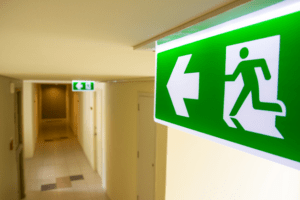In our regular legal column from Eversheds Sutherland, we hear from Catherine Henney and Charlotte Wood who explore the fire safety legal framework and guidance.

Charlotte Wood is a Senior Associate in Eversheds Sutherland’s Environment, Health and Safety Team.
The fire safety legal landscape has seen significant change in recent times, triggered by the fatal fire at Grenfell Tower in June 2017.
Since then a phased Public Inquiry has been held, which has examined the circumstances leading up to and surrounding the fire. The Public Inquiry and Dame Judith Hackitt’s Independent Review has put a spotlight on the suitability of the legal regime governing fire and building safety and since then there has been incremental legislative change.
Scope of the Fire Safety Act 2021 – what duties are imposed?
The Fire Safety Act 2021 (“the Act”) was the first major step change, which extended the scope of the Regulatory Reform (Fire Safety) Order 2005 (“FSO”) to apply, in circumstances where a building contains two or more sets of domestic premises, to the building’s structure, external walls (including cladding, windows, doors and anything attached to those walls such as balconies) and all flat entrance doors leading onto common parts.
The Government has produced a Risk Prioritisation Tool and associated ‘risk based-guidance’ which is intended to assist a ‘responsible person’ with understanding the fire safety risk profile of a building, and in determination of this, implementing suitable control measures as mitigation. This guidance can be used by a ‘responsible person’ to demonstrate compliance with the FSO and Act.
Who is the Responsible Person?
This is a common question and can be a legal conundrum. Going back to basics, the definition of ‘a responsible person’ (which can be an individual or corporate entity) has been legally defined since the enactment of the FSO. It includes:
- In the case of a workplace, the employer; and / or
- The person who has ‘control of premises’ in connection of carrying out a business such as the owner, managing agent or residents’ management company
Duties are placed on other persons, who by virtue of a contract or tenancy, are ‘in control of premises’, having an obligation to maintain or repair premises or ensuring the safety of premises. This captures risk assessors, fire system maintainers and facility management companies.
Further reading: The Building Safety Act 2022: ‘Accountable Persons’ and ‘Principle Accountable Persons’ – What do these terms mean?
It is trite law, that there can (and often is) more than one ‘responsible person’. In complex commercial arrangements or for large multi-occupied premises, it is not often clear cut who the responsible person is – and in the absence of this clarity, it can cause issues in relation to governance and fire safety management arrangements.
 At the most basic level, a tenancy and/or commercial arrangement should clearly define roles and responsibilities, an understanding of what this means in practice and assurance activities to ensure duties are being fulfilled, competently and in accordance with legal duties.
At the most basic level, a tenancy and/or commercial arrangement should clearly define roles and responsibilities, an understanding of what this means in practice and assurance activities to ensure duties are being fulfilled, competently and in accordance with legal duties.
What is the scope of The Fire Safety (England) Regulations 2022.
On 23 January 2023, the Fire Safety (England) Regulations 2022 (“the Regulations”) came into force in England only. The Regulations apply to multi-occupied residential premises with common parts which are used in the event of emergency evacuation including:
- Blocks of residential flats for use by the public, regardless of whether purpose built or converted and the type of agreement i.e. lease or rental
- Student accommodation
- Sheltered housing
- Mixed use buildings such as residential premises, above commercial
As in the case of the Act, the Regulations apply to external walls and flat entrance doors. They also extend to common parts, such as corridors and stairways on evacuation routes, walls and floors that separate domestic premises and plant rooms and other non-domestic common areas, such as gyms and offices.
Individual flats are exempt except where there are linked fire safety systems that are installed throughout the building as in the case of sprinklers, smoke detectors and communal fire alarm.
What do I need to do under the Regulations?

Catherine Henney is a Legal Director in Eversheds Sutherland’s Environment, Health and Safety Team.
The responsible person must provide easy to understand information to residents such as:
- the evacuation strategy
- how to report a fire to emergency services
- relevant information about fire doors (i.e. instructions to keep shut when not in use, not to tamper with them and reporting of faults)
This information must be displayed in a prominent part of the building, provided to occupants as soon as they move in, refreshed annually and updated information shared where there have been material changes to the content.
Are there any additional duties for buildings over 11m in height?
The extent of the legal duties ultimately depends on the height of a building and there are additional requirements beyond providing information to residents.
For buildings over 11m in height (typically over 5 storeys), responsible persons must undertake annual inspections of individual flat entrance doors and quarterly inspections on communal fire doors to check the condition and efficiency of fire doors and associated safety features such as self-closing devices.
What is the definition of high rise residential buildings?
According to the Regulations, high risk (which are by definition higher risk) residential buildings means a building containing two or more sets of domestic premises that is at least:
- 18 metres above ground (calculated from ground level to the height of the building, excluding the top storey that contains only plant and machinery); or
- has at least 7 storeys. When calculating the storeys, any storey below ground level and mezzanine floor that has a floor space of less than 50% is discounted.
What are the duties in respect of high rise residential buildings?
 In addition to the other requirements mentioned in this briefing, in respect of high rise residential buildings, responsible persons must also ensure the following:
In addition to the other requirements mentioned in this briefing, in respect of high rise residential buildings, responsible persons must also ensure the following:
- Install in a prominent position and maintain (at least annually) a secure information box, which includes the name, address and contact details of the responsible person or any other person who is permitted to access the building on behalf of the responsible person, and a copy of the floor plans and building plan.
- Document information about the design of the external building (including the risk of design and materials used when constructed) and any other pertinent information that may be relevant when responding to an emergency incident (such as any known defects in the construction). This information must be provided to the local fire and rescue service, in electronic form.
- Prepare a building plan for each floor, which must identify location(s) of all lifts (including any designed for use by firefighters or for evacuation) and essential fire-fighting equipment such as rising mains, smoke control systems and fire suppression systems. This must be provided to the local fire and rescue service, in electronic form.
- Prepare a single-one page building plan, identifying (amongst other requirements) the building’s use, dimensions, number of storeys, access points and inlets for both dry and wet rising mains.
- Undertake monthly routine checks on lifts and essential fire-fighting equipment, such as fire detection and alarm systems, evacuation alert systems and automatic door release mechanisms. The purpose is to ensure that such equipment is in efficient working order and in good repair. Any faults identified, that continue beyond 24 hours, must be reported to the local fire and rescue service and again when a repair has been undertaken.
- Ensure that the building contains suitable signage on each landing, which identifies the flat and floor numbers. Such signage must be visible in the event of fire, in particular low level lighting and smoky conditions.
What action can be taken for non-compliance?
The local fire and rescue service is the relevant regulator for the FSO, the Act and the Regulations. They have statutory powers to serve enforcement notices (requiring the responsible person to take steps to comply with the law) or prohibition notice (preventing the use of whole or part of premises). The regulator can bring criminal proceedings, where a breach of law has been identified, where an unlimited fine can be levied (and in the case of an individual, an unlimited fine, and/or a custodial sentence for up to 2 years).
So what now?
In our experience, the following top tips will assist a responsible person with demonstrating compliance:
- Cooperation and Coordination: where there is one or more responsible persons to which the FSO, Act and Regulations apply, a co-operated and co-ordinated approach to fire risk management must be applied. Roles and responsibilities must be clearly defined and followed. Whilst there is no requirement to document such arrangements, this should be encouraged to avoid ambiguity. Ongoing assurance of compliance with respective duties will provide an additional layer of reassurance.
- Review and update fire risk assessments as is necessary, ensuring that all requirements are captured.
- Appoint a competent person to assist with compliance. A responsible person need not appoint consultants or experts, and can rely on internal resource, provided that the nominated employee has sufficient training, competence and time. Where external contractors are appointed, the responsible persons must undertake assurance of the qualifications, skills, experience and competence to undertake the role (i.e. as in the case of risk assessors) on appointment and throughout the contract, at necessary intervals to ensure that delegated duties are being carried out.
- Record keeping is key – including the date and outcome of fire door inspections, date of residents’ briefings, fire risk assessments prepared and updated and any actions arising from those etc.
- Work with and maintain a good relationship with occupiers, to highlight the importance of the requirements under the Regulations and that their active engagement is necessary, particularly where annual access is required to carry out checks on individual flat entrance doors. Guidance issued by the Government advises that all new agreements, such as leases, should include a right to access for the purpose of undertaking checks to maintain compliance with the Regulations.
- Engage with the local fire and rescue service to provide necessary information. An invitation to undertake a familiarisation tour of the building will enhance the emergency evacuation arrangements.
Charlotte Wood is a Senior Associate in Eversheds Sutherland’s Environment, Health and Safety Team. She can be contacted on [email protected]. Catherine Henney is a Legal Director in Eversheds Sutherland’s Environment, Health and Safety Team. She can be contacted on [email protected].
Fire Safety in 2023 eBook
SHP's sister site, IFSEC Insider has released its annual Fire Safety Report for 2023, keeping you up to date with the biggest news and prosecution stories from around the industry.
Chapters include important updates such as the Fire Safety (England) Regulations 2022 and an overview of the new British Standard for the digital management of fire safety information.
Plus, explore the growing risks of lithium-ion battery fires and hear from experts in disability evacuation and social housing.


 At the most basic level, a tenancy and/or commercial arrangement should clearly define roles and responsibilities, an understanding of what this means in practice and assurance activities to ensure duties are being fulfilled, competently and in accordance with legal duties.
At the most basic level, a tenancy and/or commercial arrangement should clearly define roles and responsibilities, an understanding of what this means in practice and assurance activities to ensure duties are being fulfilled, competently and in accordance with legal duties.
 In addition to the other requirements mentioned in this briefing, in respect of
In addition to the other requirements mentioned in this briefing, in respect of